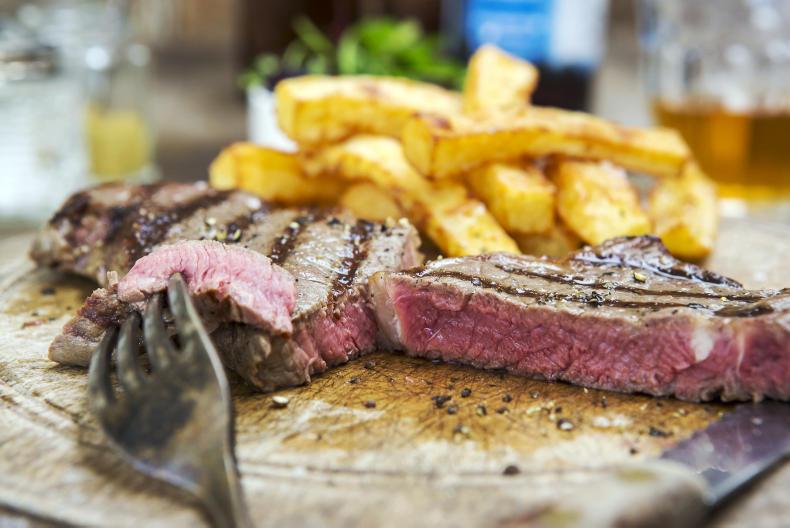You would be surprised how often I am asked at demos about how to cook the perfect steak and what the difference is between the various cuts of meat. This is one of the reasons I am so keen for schools to teach about food, as learning about and understanding what we eat is, I believe, very important for our long-term health.
So, this week, I’ve included a quick guide to the main cuts, and how to cook them. Remember: your butcher will always be glad to help too. In the restaurant, we get our beef from Country Crest in Lusk, and we are delighted with its quality and consistency.
Chips are really the perfect food to accompany the steak. Homemade chips should be perfectly crispy on the outside and super-fluffy on the inside. The secret is to cook them twice, at two different temperatures. So you will need a deep-fat fryer or deep pan and a thermometer for this recipe.
The perfect steak
1 Choose a heavy-duty frying pan with a thick base and, ideally, with a non-stick coating to achieve good results. Alternatively, use a heavy griddle pan or cast-iron frying pan. Heat oven to a moderate heat for fillet, hot for sirloin or striploin and very hot for rib-eye. Season with salt and pepper just before cooking them. Don’t be tempted to season a steak until just before cooking, as salt draws out moisture from the meat.
2 Add a swirl of olive oil, then add the steaks and cook for one and a half to two and a half minutes on each side for medium rare. Add a lightly crushed garlic clove and fresh thyme sprig for extra flavour, if liked.
3 The exact time will depend on the thickness of the steaks, and fillet steaks take a little less time. Allow a minute or two longer if you prefer your steaks more well done.
4 For fillet steak, you’ll need to cook it around the edges too. Do not be tempted to pierce the steak while it is cooking or to turn it too often: once in enough.
5 An accurate way to check how well-done your steak is, is to press the steak lightly with your fingertip. When rare it will feel soft, medium-rare will be slightly bouncy, and well-done will be much firmer.
6 Add a knob of butter to the pan, and allow it to foam a little, then baste the steaks with this. Transfer to a plate and rest for five to 10 minutes. This allows the fibres of the meat to relax and reabsorb the free-running juices. Slice along the grain, cutting off any fat. then arrange on warmed serving plates with some chunky chips.
Homemade chips
Serves 4
1.2 litres (2 pints) vegetable oil, for deep-frying
4 large Rooster potatoes (about 1.5kg (3lb 4oz)
good pinch of fine salt
1 Trim the potatoes into rectangles, then cut them into 1cm (½-inch) slices, then cut the slices again to give chips that are 1cm (½-inch) wide.
2 Rinse the chips in plenty of cold water to remove the excess starch and then, if time allows, leave them to sit in water for a couple of hours or even overnight.
3 If you are using a deep-fat fryer, heat the vegetable oil to 95°C (200°F). Alternatively, fill a deep, heavy-based pan to one third with oil and use a sugar thermometer to check that it has reached the correct temperature. Take great care if using a pan: always watch over it and never fill it more than a third, as hot fat may bubble up when the potatoes are added.
4 Drain the chips and dry really well on kitchen paper, then place into the heated oil and cook for 10 minutes. This blanches them and ensures that they are completely cooked through without colouring them.
5 Check the chips are tender using the point of a knife, then remove from the oil using a slotted spoon if using a pan and drain on kitchen paper.
6 These can be left to cool on greaseproof paper and can even be chilled for several hours before finishing.
7 Preheat the oil in the fryer or pan to 190°C (375°F). Lower the blanched chips into the oil and cook for another two to three minutes, until crisp and golden brown.
8 Shake off any excess fat and then quickly drain on kitchen paper. Sprinkle with a little salt to serve.CL
The Basics: HOW TO CHOOSE THE RIGHT STEAK
Striploin: perfect all-rounder. The most famous of steaks, this prime cut is gently marbled and has a melt-in-the-mouth succulence. It is almost as tender as the fillet, but with a more generous portion size will satisfy the heartiest of appetites.
Rib-eye: the chef’s favourite. This cut has an open-fibre texture and a marbling of creamy fat. Cook with the surrounding fat still attached, then remove it afterwards. The fat adds flavour as well as basting the meat during the cooking process.
Fillet: the most expensive cut. It is very lean and, because it has short fibres, very tender. The best pieces come from the middle of the fillet, not the end. It is also important to remove the sinewy chains that run down the side. Each fillet is carefully hand-cut into the perfect portion for one.
Sirloin: great for all the family. It has a good marbling of fat with a layer of creamy fat on one side. This should be left on for cooking, then removed if you like. It has a unique flavour with a stronger, more mature taste.
Whatever steak you decide on, do remove it from the packaging and allow it to come back up to room temperature for at least 20 minutes before starting to cook.






 This is a subscriber-only article
This is a subscriber-only article










SHARING OPTIONS: